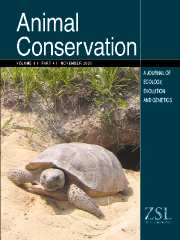Crossref Citations
This article has been cited by the following publications. This list is generated based on data provided by
Crossref.
Curnutt, John L.
Mayer, Audrey L.
Brooks, Thomas M.
Manne, Lisa
Bass, Oron L.
Fleming, D. Martin
Nott, M. Philip
and
Pimm, Stuart L.
1998.
Population dynamics of the endangered Cape Sable seaside‐sparrow.
Animal Conservation,
Vol. 1,
Issue. 1,
p.
11.
Walters, Jeffrey R.
Beissinger, Steven R.
Fitzpatrick, John W.
Greenberg, Russell
Nichols, James D.
Pulliam, H. Ronald
and
Winkler, David W.
2000.
Conservation Report: The AOU Conservation Committee Review of the Biology, Status, and Management of Cape Sable Seaside Sparrows: Final Report.
The Auk,
Vol. 117,
Issue. 4,
p.
1093.
Walters, Jeffrey R.
Beissinger, Steven R.
Fitzpatrick, John W.
Greenberg, Russell
Nichols, James D.
Pulliam, H. Ronald
and
Winkler, David W.
2000.
The AOU Conservation Committee Review of the Biology, Status, and Management of Cape Sable Seaside Sparrows: Final Report.
The Auk,
Vol. 117,
Issue. 4,
p.
1093.
Pelley, Janet
2000.
Restoring Our Rivers.
Environmental Science & Technology,
Vol. 34,
Issue. 3,
p.
86A.
Curnutt, John L.
Comiskey, Jane
Nott, M. Philip
and
Gross, Louis J.
2000.
LANDSCAPE-BASED SPATIALLY EXPLICIT SPECIES INDEX MODELS FOR EVERGLADES RESTORATION.
Ecological Applications,
Vol. 10,
Issue. 6,
p.
1849.
Walters, Jeffrey R.
Beissinger, Steven R.
Fitzpatrick, John W.
Greenberg, Russell
Nichols, James D.
Pulliam, H. Ronald
and
Winkler, David W.
2000.
The AOU Conservation Committee Review of the Biology, Status, and Management of Cape Sable Seaside Sparrows: Final Report.
The Auk,
Vol. 117,
Issue. 4,
p.
1093.
Sklar, F.H
Fitz, H.C
Wu, Y
Van Zee, R
and
McVoy, C
2001.
SOUTH FLORIDA: THE REALITY OF CHANGE AND THE PROSPECTS FOR SUSTAINABILITY.
Ecological Economics,
Vol. 37,
Issue. 3,
p.
379.
Taylor, James W.
and
Buizza, Roberto
2004.
A comparison of temperature density forecasts from GARCH and atmospheric models.
Journal of Forecasting,
Vol. 23,
Issue. 5,
p.
337.
Redden, David T.
Fernández, José R.
and
Allison, David B.
2004.
A simple significance test for quantile regression.
Statistics in Medicine,
Vol. 23,
Issue. 16,
p.
2587.
Armentano, Thomas V.
Sah, Jay P.
Ross, Michael S.
Jones, David T.
Cooley, Hillary C.
and
Smith, Craig S.
2006.
Rapid responses of vegetation to hydrological changes in Taylor Slough, Everglades National Park, Florida, USA.
Hydrobiologia,
Vol. 569,
Issue. 1,
p.
293.
Cassey, Phillip
Lockwood, Julie L.
and
Fenn, Katherine H.
2007.
Using long-term occupancy information to inform the management of Cape Sable seaside sparrows in the Everglades.
Biological Conservation,
Vol. 139,
Issue. 1-2,
p.
139.
Baiser, B.
Boulton, R. L.
and
Lockwood, J. L.
2008.
Influence of water depth on nest success of the endangered Cape Sable seaside sparrow in the Florida Everglades.
Animal Conservation,
Vol. 11,
Issue. 3,
p.
190.
Cade, Brian S.
and
Dong, Quan
2008.
A quantile count model of water depth constraints on Cape Sable seaside sparrows.
Journal of Animal Ecology,
Vol. 77,
Issue. 1,
p.
47.
Elderd, B. D.
and
Nott, M. Philip
2008.
Hydrology, habitat change and population demography: an individual‐based model for the endangered Cape Sable seaside sparrow Ammodramus maritimus mirabilis.
Journal of Applied Ecology,
Vol. 45,
Issue. 1,
p.
258.
2008.
Modern Regression Methods.
p.
550.
Johnson, Chris N.
and
VanDerWal, Jeremy
2009.
Evidence that dingoes limit abundance of a mesopredator in eastern Australian forests.
Journal of Applied Ecology,
Vol. 46,
Issue. 3,
p.
641.
JAREMA, STACEY I.
SAMSON, JASON
MCGILL, BRIAN J.
and
HUMPHRIES, MURRAY M.
2009.
Variation in abundance across a species' range predicts climate change responses in the range interior will exceed those at the edge: a case study with North American beaver.
Global Change Biology,
Vol. 15,
Issue. 2,
p.
508.
Bottai, Matteo
and
Zhang, Jiajia
2010.
Laplace regression with censored data.
Biometrical Journal,
Vol. 52,
Issue. 4,
p.
487.
Yuan, Ying
and
Yin, Guosheng
2010.
Bayesian Quantile Regression for Longitudinal Studies with Nonignorable Missing Data.
Biometrics,
Vol. 66,
Issue. 1,
p.
105.
Ma, Yanyuan
and
Yin, Guosheng
2010.
Semiparametric median residual life model and inference.
Canadian Journal of Statistics,
Vol. 38,
Issue. 4,
p.
665.


